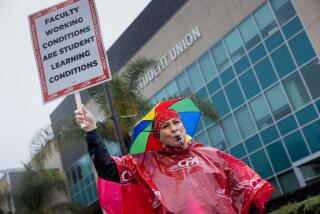State of the Nonunion
- Share via
NEW YORK — Professor Marcus Sandver remembers clearly how for years faculty members at Ohio State University had politely asked the administration for dental insurance and were refused.
“The university always told us, ‘We can’t afford it,’ ” said Sandver, a professor of management and human resources and a member of the school’s nonunion faculty.
But when orderlies belonging to Local 4501 of the Communications Workers of America threatened to strike the university hospital over dental insurance, “boom! they got it and within two months the rest of us had it too,” Sandver recalled.
The faculty, he said, owe their brighter smiles to the union, since they cashed in on what he termed the spillover effect.
“The fact is that when the members of [a union] bargaining unit get an increase in wages, health insurance, pensions or vacation days, the management people are all going to get increases too,” Sandver said.
“Spillover” also radiates outward to nonunion workers at other companies “who are going to get pay increases as the unions put competitive pressure on employers in the labor market,” he said.
According to Ray Adkins, the executive secretary of the nonunion Confidential Office Personnel Assn. in Fort Lauderdale, Fla., “When some workers are getting union pay scales, nonunion employers have got to pay close [attention] to it to get the people they need and want.”
After unionized secretaries in the public schools won raises each year from 1993 to 1996, Confidential Office Personnel petitioned for, and got, raises for its secretaries, Adkins said. Last year’s 4% hike tacked $1,000 on to the pay of a Confidential Office Personnel secretary earning $25,000.
“Many employers will pay even higher than the union wage,” said Ray Hilgert, industrial relations professor at Washington University in St. Louis, “because they don’t want the union to come in and have the restrictions of the union contract.
“If a company really does a good job treating its people well, what’s a union going to do for them that’s not already there?” Hilgert asked.
Ohio State’s Sandver predicts that at United Parcel Service of America, “even management people who were working as strikebreakers against the Teamsters are going to benefit from the increase that production workers will get.”
In a statistic sure to warm the hearts of Teamster officials, 55% of the public supported the Teamsters and the UPS workers who were on strike for 15 days in August, according to a CNN/USA Today Gallup poll. Only 27% of those polled backed UPS management.
However, this surge of public support does not necessarily mean that nonunion workers, who make up 86% of the employed, recognize spillover. It may have more to do with animosity toward management. As pollster Geoffrey Garin told the New York Times, “There’s been a pendulum shift that’s led people to support unions in disputes with management because Americans have gotten a much more jaundiced view of how corporations treat workers.”
The public, according to management guru Peter Drucker of Claremont Graduate School, is having a visceral reaction to the exorbitant salaries some execs pay themselves. He told Forbes magazine: “Few top executives can even imagine the hatred, contempt and fury that has been created--not primarily among blue-collar workers who never had an exalted opinion of the ‘bosses’--but among their middle management and professional people.”
More to Read
Sign up for Essential California
The most important California stories and recommendations in your inbox every morning.
You may occasionally receive promotional content from the Los Angeles Times.













